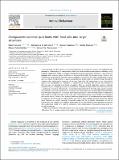Files in this item
Chimpanzees combine pant hoots with food calls into larger structures
Item metadata
| dc.contributor.author | Leroux, Maël | |
| dc.contributor.author | Bosshard, Alexandra B. | |
| dc.contributor.author | Chandia, Bosco | |
| dc.contributor.author | Manser, Andri | |
| dc.contributor.author | Zuberbühler, Klaus | |
| dc.contributor.author | Townsend, Simon W. | |
| dc.date.accessioned | 2021-07-27T20:30:30Z | |
| dc.date.available | 2021-07-27T20:30:30Z | |
| dc.date.issued | 2021-09 | |
| dc.identifier | 275213642 | |
| dc.identifier | be7affb2-8014-4811-a480-d62c9b9cd8f9 | |
| dc.identifier | 85110679946 | |
| dc.identifier | 000693411000003 | |
| dc.identifier.citation | Leroux , M , Bosshard , A B , Chandia , B , Manser , A , Zuberbühler , K & Townsend , S W 2021 , ' Chimpanzees combine pant hoots with food calls into larger structures ' , Animal Behaviour , vol. 179 , pp. 41-50 . https://doi.org/10.1016/j.anbehav.2021.06.026 | en |
| dc.identifier.issn | 0003-3472 | |
| dc.identifier.other | RIS: urn:779DD3DE73ED0E2004CD3716403FA498 | |
| dc.identifier.other | ORCID: /0000-0001-8378-088X/work/97884604 | |
| dc.identifier.uri | https://hdl.handle.net/10023/23656 | |
| dc.description | This work was supported by the Swiss National Science Foundation (PP00P3_163850) to S.W.T. and the NCCR Evolving Language (Swiss National Science Foundation Agreement #51NF40_180888). | en |
| dc.description.abstract | A growing body of observational and experimental data in nonhuman primates has highlighted the presence of rudimentary call combinations within the vocal communication system of monkeys. Such evidence suggests the ability to combine meaning-bearing units into larger structures, a key feature of language also known as syntax, could have its origins rooted within the primate lineage. However, the evolutionary progression of this trait remains ambiguous as evidence for similar combinations in great apes, our closest-living relatives, is sparse and incomplete. In this study, we aimed to bridge this gap by analysing the combinatorial properties of the pant hoot–food call combination in our closest-living relative, the chimpanzee, Pan troglodytes. To systematically investigate the syntactic-like potential of this structure, we adopted three levels of analysis. First, we applied collocation analyses, methods traditionally used in language sciences, to confirm the combination of pant hoots with food calls was not a random co-occurrence, but instead a consistently produced structure. Second, using acoustic analyses, we confirmed pant hoots and food calls comprising the combination were acoustically indistinguishable from the same calls produced in isolation, indicating the pant hoot–food call combination is composed of individually occurring meaning-bearing units, a key criterion of linguistic syntax. Finally, we investigated the context-specific nature of this structure, demonstrating that the call combination was more likely to be produced when feeding on larger patches and when a high-ranking individual joined the feeding party. Together our results converge to provide support for the systematic combination of calls in chimpanzees. We highlight that playback experiments are vital to robustly disentangle both the function this combination might serve and the similarities with combinations of meaning-bearing units (i.e. syntax) in language. | |
| dc.format.extent | 10 | |
| dc.format.extent | 1357189 | |
| dc.language.iso | eng | |
| dc.relation.ispartof | Animal Behaviour | en |
| dc.subject | Call combination | en |
| dc.subject | Evolution of language | en |
| dc.subject | Great ape | en |
| dc.subject | Nonhuman primate | en |
| dc.subject | Syntax | en |
| dc.subject | Pan troglodytes schweinfurthii | en |
| dc.subject | QL Zoology | en |
| dc.subject | BF Psychology | en |
| dc.subject | NDAS | en |
| dc.subject.lcc | QL | en |
| dc.subject.lcc | BF | en |
| dc.title | Chimpanzees combine pant hoots with food calls into larger structures | en |
| dc.type | Journal article | en |
| dc.contributor.institution | University of St Andrews. School of Psychology and Neuroscience | en |
| dc.contributor.institution | University of St Andrews. Institute of Behavioural and Neural Sciences | en |
| dc.contributor.institution | University of St Andrews. Centre for Social Learning & Cognitive Evolution | en |
| dc.identifier.doi | 10.1016/j.anbehav.2021.06.026 | |
| dc.description.status | Peer reviewed | en |
This item appears in the following Collection(s)
Items in the St Andrews Research Repository are protected by copyright, with all rights reserved, unless otherwise indicated.

